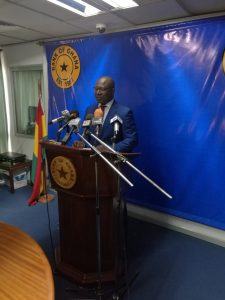 The Monetary Policy Committee (MPC) of the Bank of Ghana (BoG) has maintained its policy rate at 26% for consecutive times this year, citing a balanced risks to inflation and growth.
The Monetary Policy Committee (MPC) of the Bank of Ghana (BoG) has maintained its policy rate at 26% for consecutive times this year, citing a balanced risks to inflation and growth.
The policy rate is the rate at which the Central Bank does its overnight lending to the universal banks in the country.
It also influences commercial bank lending rates in the country which are hovering around 29 to 35 percent according to the bank.
With the keeping of the rate, all the 28 banks are expected to keep their base rates unchanged.
Addressing journalists in Accra, the Governor of the BoG, Dr. Henry Wampah who is also the Chairman of the MPC, explained that price developments, since the January MPC meetings, show that headline inflation moved up significantly to 19 percent in January 2016 from 17.7 percent in December 2015.
“This was due to the impact of the hikes in utility tariffs and levies on petroleum products. In February, however, headline inflation declined to 18.5 percent, dragged down by lower non-food inflation.
The monthly inflation rates also indicated some slowdown in February, supported largely by stability in the exchange rate”.
He added that Core inflation (CPI inflation excluding energy and utility prices) has trended downwards since December 2015, pointing to some easing of underlying inflation pressures.
The drop in both headline and core inflation is encouraging, but the current levels of inflation remain significantly above the medium term target band of 8±2 percent, Dr Wampah told journalists in Accra today.
The latest survey of businesses, consumers and the financial sector show that inflation expectations are still high, driven largely by the upward adjustments in utility tariffs and petroleum prices.
Although elevated, there is no clear evidence of a further deterioration in inflation expectations in the near term.
The bank’s forecasts indicate that, barring any further shocks, inflation will peak in the first quarter of 2016, and gradually decline thereafter towards the target band by mid-2017, same as January forecast.
According to Dr Wampah, the upside risks to the inflation outlook include uncertainties regarding the second round effects of the upward adjustment of the transportation costs and the tight external financing conditions.
The January 2016 update of the Bank’s Composite Index of Economic Activity (CIEA) points to some improvement in the pace of economic activity.
Also, the latest confidence surveys show that both consumer and business sentiments on general economic conditions are somewhat positive.
Despite the modest pickup in the CIEA, general growth conditions remain subdued reflecting the tight policy stance, declining private sector credit growth and lingering concerns about the energy crisis.
It is anticipated that the turnaround in the energy situation, additional oil and gas production and improvement in the macroeconomic environment would further boost growth later in the year.
African Eye Report




